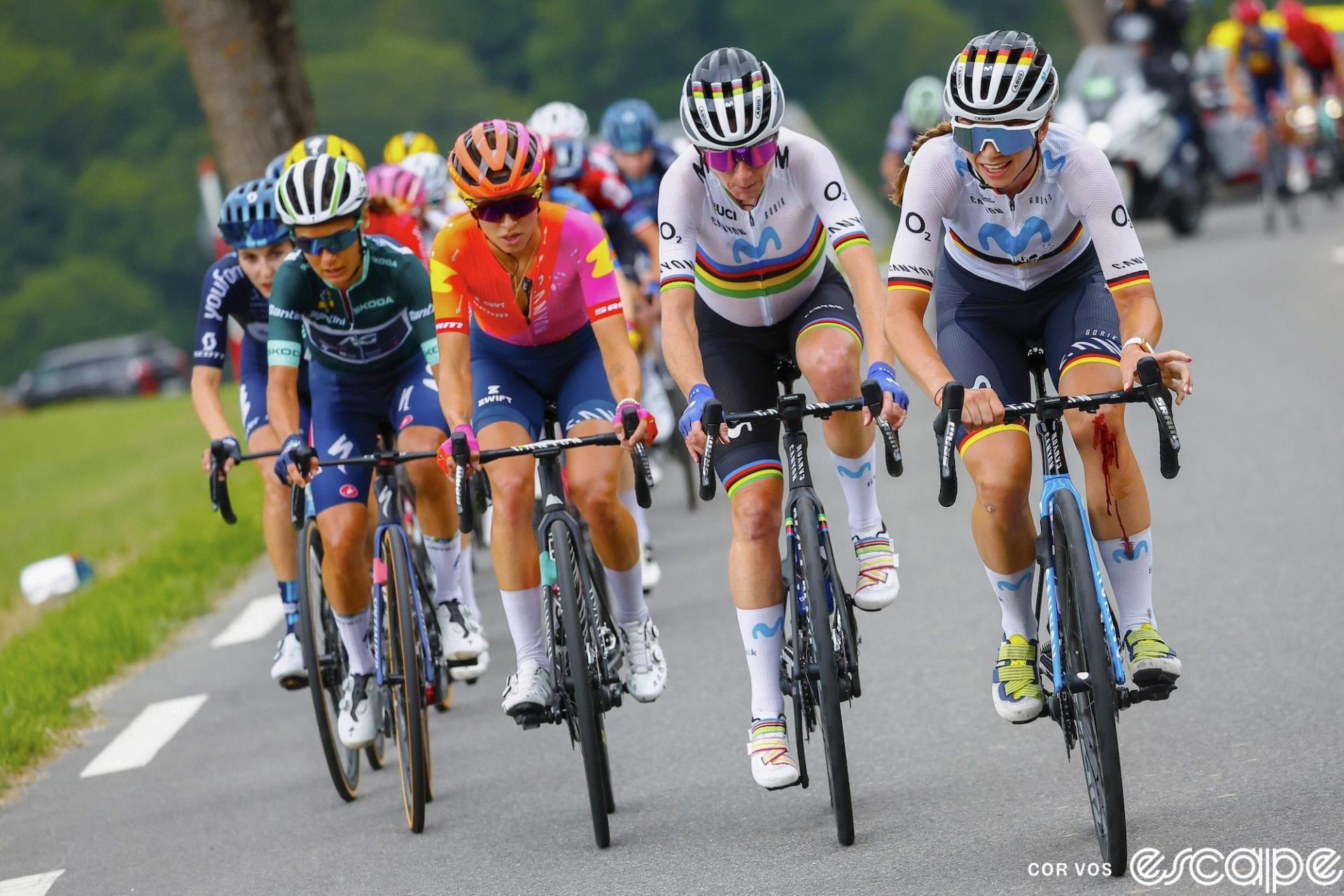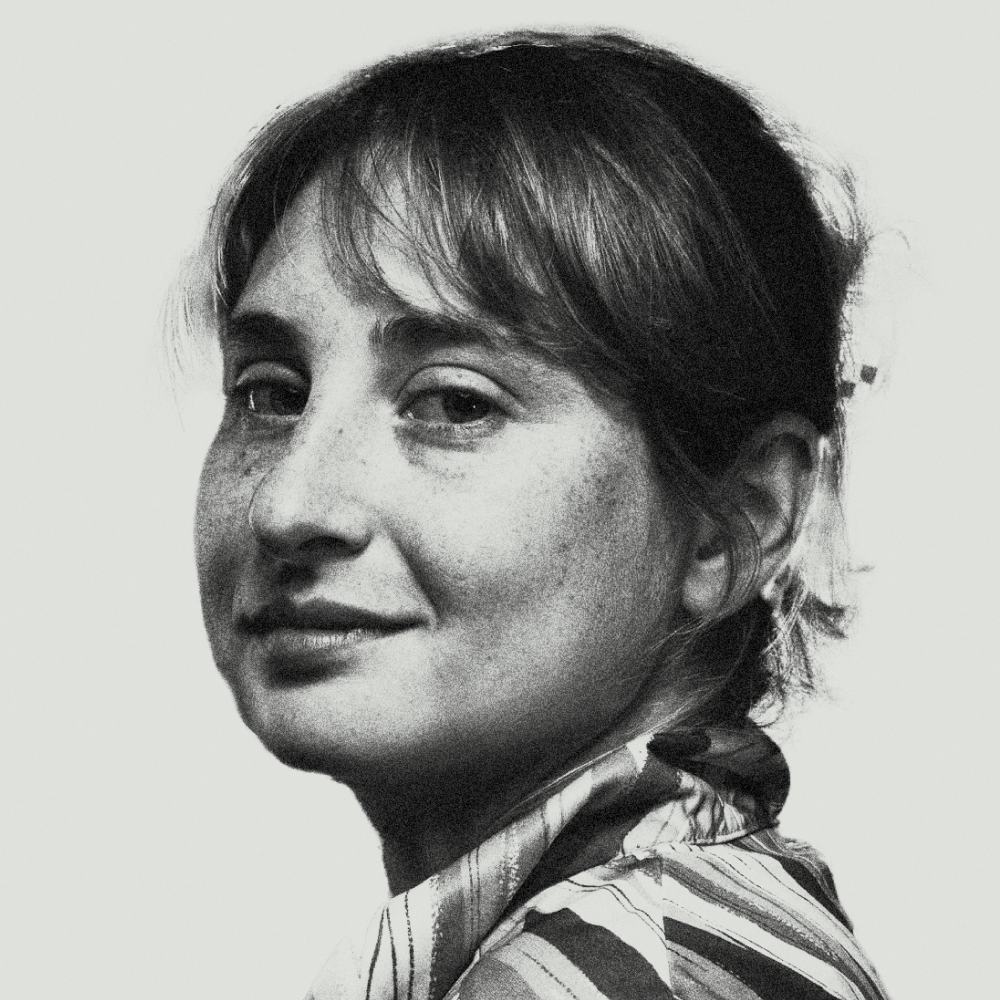The Col d’Aspin looms around the corner, where the dark hills meet. When the peloton finally reaches it, it does so anxiously. The women throw out their bottles. Some, like Marianne Vos, quit while they’re ahead. This is not their day. It is a series of compressions and rarefactions, like a wave of sound, when they round the hairpins.
Already Movistar is working for Annemiek van Vleuten, and already SD Worx’s Marlen Reusser is watching behind. Cars intermingle with women on the narrow road. Three of Van Vleuten’s teammates are shelled out the back. The week is coming back to hurt riders like Emma Norsgaard, yesterday’s winner, and Yara Kastelijn, a stage winner and bearer of the polka dot jersey. Them, and surely many others.
Paula Patiño pulls big-time for the World Champion. One wonders if it will all be over even before they reach the base of the Tourmalet. An entire second peloton has already formed and is a minute back. The day is violently difficult. The word attrition never found such a visceral example. Liane Lippert, after her long pull for Van Vleuten, expires. Five kilometers to the top.
Van Vleuten sets out early, early, early, with Demi Vollering and Kasia Niewiadoma for company. It seems impossible that this has already happened, and yet also inevitable. That’s the paradox of dominance. But nothing is ever over, especially in the mountains. Hence, the others are saving it. They hope Van Vleuten will wear herself out – that she will fly too close to the sun.
Behind, it’s amazing that Lotte Kopecky is still in the pursuing group with the likes of Cecilie Uttrup Ludwig, Ashleigh Moolman Pasio, and Juliette Labous. That group just has to work together. They have numbers and time and the collective struggle against the wind on their side. Up front, the other two won’t want to give Van Vleuten more than they owe her. Vollering refuses to pull at all. The final kilometer slowly unwinds, and even though the leaders have 50 seconds, their minds will be on the descent. They reach it. Now it is counting.
The fog emerges as the hill winds down.
Niewiadoma is reaming down the hills, the other two more cautious. The fog does not brush the road, rather it is combed through the trees. Vollering’s lines keep Van Vleuten in check. Niewiadoma is in a class on her own, pulling out ribbons of road. The others behind are not taking the same risks. Vollering and Van Vleuten watch each other warily. Vollering even tells Van Vleuten, no, you work. She gestures.

Behind, Reusser and Kopecky discuss what’s going on up front, much to the chagrin of others. With the duo out front, now the brakes come out. It’s a stalemate. And Niewiadoma keeps riding, riding, riding. Forty-five seconds, later a minute, with a tailwind. Her Tourmalet is different from others’. She will go into it alone as the sky darkens.
Vollering and Van Vleuten’s hesitancy has brought them back into the arms of the pursuers, rendering their assault null. Reusser knows her job. She leads the two and Moolman-Pasio through the corners and has split them from the others. They sprint to catch up. Cavalli dangles. Kopecky still hangs on. Reusser leans into the work of finding the interloper Niewiadoma. Now, on the gentler slopes, is the time to do it.
Yet it doesn’t happen.
Niewiadoma has 50 seconds. Behind, Labous starts to pull. At nine kilometers to go, the fog blankets the road. The lush greenery is wasted on those eyes which can only stare directly ahead. It is a long, long, long climb. They still have four kilometers before they even pass the press room. Labous goes again, but again there is nothing.
Questions arise. Is Van Vleuten too exhausted from her attack before? Is she not well? Will Kopecky, against all odds, be able to hold on to her yellow jersey and secure it through the time trial? Vollering in the mist makes her move. It is at this point where I go outside. In the fog, it is so thick you cannot see your hand in front of your face. You cannot see a meter in front of you. The motorbike lights are pinpricks in the great beyond, flaring out into fluorescent spheres. By the time they arrive, it is, to my utter shock, Vollering who passes first. That is the nature of fog of unknowing. Niewiadoma is behind, then Van Vleuten, her kit soaked with sweat.
But there is a great pause between all three. The pauses are now made even more poignant in the mist. It is not just that the space between them can be measured in time or in distance. It is that they cannot see each other and we cannot see them. They can barely see the fans cheering on the side of the road.
The road is only as long as the fog allows. It must feel even longer for them. It must feel long for the overwhelming favorite Van Vleuten who played her cards too early and has to finish the climb with the consequences. It must feel long for Lotte Kopecky who wore the yellow jersey with valor for the vast majority of the Tour and almost kept it until that final, explosive moment eradicated whatever pretensions of victory were left into dust. However, this climb must feel especially long for Kasia Niewiadoma, who was once as far ahead as she now is behind, even further now, drifting into the abyss of the mountain unable to view either the end or the next kind face.
Vollering, however, is flying, soaring through the fog, which she surely remembers from her Vuelta Femenina win on Lagos de Covadonga. There is nothing standing in her way now except for whatever is within her, which to us is unknowable. As long as the day has seemed, and it is long, it is now almost over. The scales tip from impossible to possible, from endless to defined. Time is on her side and so is power. She has outsmarted and outpaced and outridden. The flamme rouge welcomes her into the hall of champions who have at last toppled this great mountain. And under it, she begins to realize.
Cycling is a sport for the brave – for Niewiadoma, in her high-risk move to cause Van Vleuten and Vollering to watch each other, foiled a plan that at first retained a final, deadly certainty. It is a sport of dedication and solidarity – for Liane Lippert, who suffered a crash and terrain that isn’t hers, who endures totalizing pain solely for the benefit of another. It is a sport of intrigue, yet this is a situational intrigue that can be overcome by brute strength.
All the cunning in the world could not save Van Vleuten from the deadly strike of Vollering. It is a sport that spans the long term – the team plan that must be made from kilometer zero of the very first stage, the plan Movistar made at the beginning of the Col d’Aspin – and the short, the millisecond firing of synapses in the brain which directs electricity to the muscles in the legs that forces them into an irreversible moment of action, the moment which infallibly leads to something we call an ending.
The finish line is so blurred in mist that the finish is softened by it. Vollering cheers, her head tucked to the side, mist and sweat and perhaps even tears collecting in her eyelashes. What this means to her is profound, especially after the setbacks her team faced this week, especially because her teammate Kopecky is coming to greet her, to take her in her arms, especially because the mountain holds such mythical importance in the pantheon of cycling and because she is the first woman to conquer it in a Tour de France for longer than she has been alive. Would you, if you were her, not also cry?
What did you think of this story?

